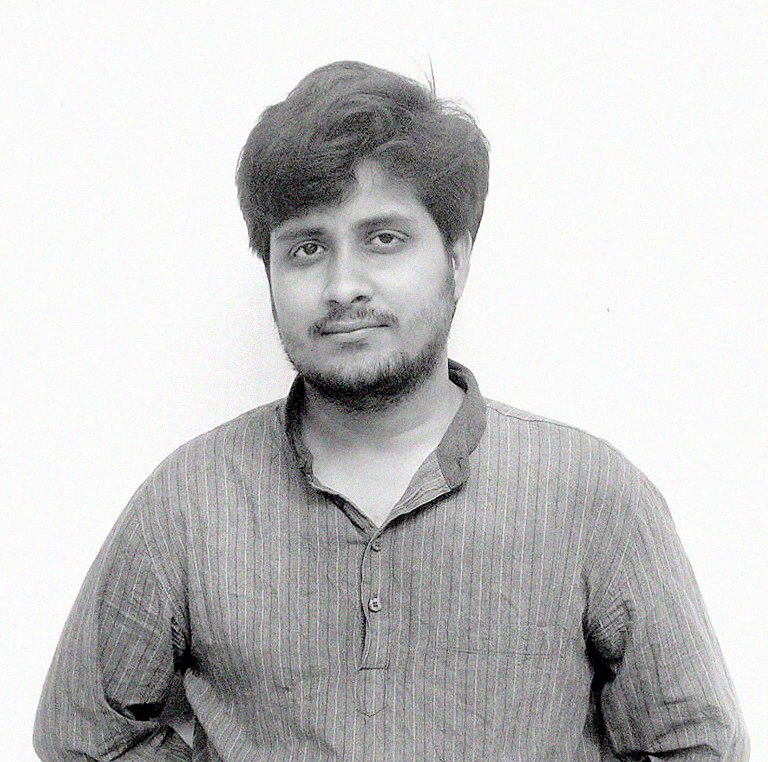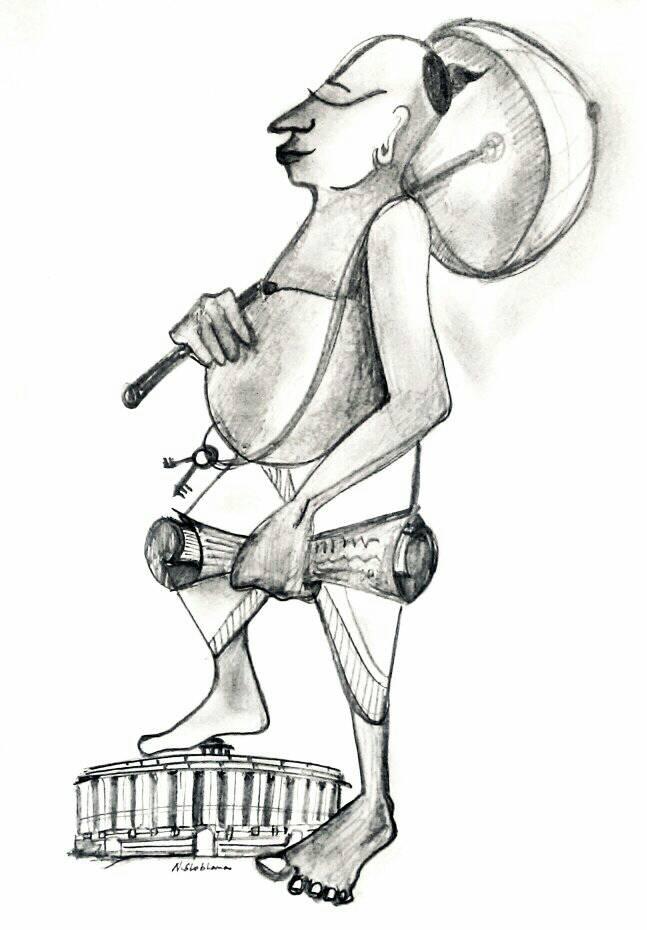Pinak Banik
Continued from here.
 Prof. Habib advances, saying, “a concept of India, politically independent, is already present in 1857. But was it sufficient?”, “something more was needed to turn India from a ‘country’ into a ‘nation’.Two stages seem to me to be very important for such conversion. First of all, there had to be a realization that an independent country, a free India would be different.”
Prof. Habib advances, saying, “a concept of India, politically independent, is already present in 1857. But was it sufficient?”, “something more was needed to turn India from a ‘country’ into a ‘nation’.Two stages seem to me to be very important for such conversion. First of all, there had to be a realization that an independent country, a free India would be different.”
Then sheds light on these two stages, discussing social reforms and Bengal renaissance.
“The initial voice was that of Ram Mohan Roy, who by the way knew Persian, Arabic, Sanskrit, English, French, and Hebrew, being really a polymath. He wrote his first book (Tuhfatu’lMuwahhidin)’ in Persian. He said in 1828 that Indians can’t be patriotic because they are divided up among castes. If caste affinities continue, how can there be any patriotism for the country? And therefore the social reform movement, particularly as initiated by Keshav Chandra Sen (1838-84) was so important. He has practically been forgotten today; but look at the man who at the age of 18 or 20 was writing that untouchability must be abolished, inter-caste marriages should be allowed, women should have equality with men in inheritance and every other right, modern education should be spread among women. And he created a new BrahmoSamaj some of whose members by the way ate beef, which show that there were Indians who could defy religious orthodoxy. But that was a small thing; the real thing was that they made social reform movement possible. Everywhere these demands arose—abolition of untouchability, equal rights for women, and modern education. And Keshav Chandra Sen said in 1870 that as social reform progresses, India will become a nation, since India could only become a nation if its division into castes and religious communities was overcome.”
Brahmo Sabha was first initiated by Raja Rammohan Roy and Debendranath Tagore in 1828, to reform mainstream Brahmanism of that time. It was a challenging time for Brahmanism, as England’s Baptist Christianity and the concept of the Holy Spirit had entered Bengal, with the arrival of the East India Company. William Carey, who founded the Baptist Missionary Society, came to India in 1793 and later translated the Bible into Bengali (completed 1809) and Sanskrit (completed 1818). The Bible was translated to other Indian languages too, and Christianity was spreading among the people in Bengal.
The first Bengali who converted to Christianity was Krishna Pal, a Shudra.The Church made an effort to repudiate the caste distinctions. Ram Mohan admired the Christian theology and at the same time thought- “some change should take place in their religion (Hinduism), at least for the sake of their political advantage and social comfort”, “superstitious practices (sati, caste rigidity, polygamy and child marriages) which deform the Hindu religion have nothing to do with the pure spirit of its dictates”. Later, the crusader for universal brotherhood, Rabindranath Tagore, who subscribed to the same school of thought, reflected on it, in his 1925 essay “Shudra Dharma”!
So Ram Mohan launched the Brahmo Dharma (Brahmoism) with it’s trust deed aiming at “the worship and adoration of the Eternal Unsearchable and Immutable Being who is the Author and Preserver of the Universe, but not under or by any other name designation or title peculiarly used for and applied, to any particular being or beings by any man or set of men whatsoever”. The Holy Spirit of Christianity and “the One True God” were used to camouflage Brahma as Bahmoism.
“He (Ram Mohan) adapted his measures, however, to the times in which he lived, and to the men whom he sought to enlighten; and accordingly we find him preserving his own Brahminical dignity, and maintaining it to be his duty to instruct his countrymen in the true meaning of their sacred books. Thus, in the public services of the Samaj, the Upanishads, and not the New Testament, were the authorized scriptures, and caste practices were still observed.” – (‘Keshab Chandra Sen and the Brahma Samaj: being a brief review of Indian theism from 1830 to 1884’ :T. E. Slater)
Ram Mohan had practiced certain superstitions in Hinduism throughout his life. He never discarded the sacred thread; the insignia of his caste till his death and throughout his life recited the Gayatri Mantra.
Ram Mohan left for England in 1930, and the Brahma Sabha continued their weekly services, which was “consisting of three successive parts: recitation of the Vedas by Telugu Brahmins in the closed apartment exclusively before the Brahmin members of the congregation, reading and exposition of the Upanishads for the general audience, and singing of hymns. The reading of the Vedas was done exclusively before the Brahmin participants as the orthodox Telugu Brahmin community and its members could not be persuaded to recite the Vedas before Brahmins and non-Brahmins alike.” – (H.C.Sarkar-History of the Brahmo Religion).
Ram Mohan always took a Brahmin cook along with him on his trips, and even the last time (after attempts to reform Hinduism, and the abolition of Sati), till he died of meningitis in Stapleton, Bristol, in 1833.
Later, the first Brahma Samaj (1861) was founded by Pandit Navin Chandra Roy in Lahore with the Bengalis from the Lahore Bar Association. In 1960, Brahmo Anusthan (code and conduct of practice) was published in Calcutta, and declared to have divorced itself from mainstream Hinduism. In 1866, Keshav Chandra Sen organized his own “radical” “Brahmo Samaj of India” with overtones of Christianity. Keshav Chandra campaigned for the education of women, against child marriage, property inheritance rights for women etc., (although within his own upper caste circle).The same “radical” reformist had conducted the marriage of his underaged daughter in 1878. But he still remains radical in your narrative because he ate beef!
Later in his life, he came under the influence of Ramakrishna (Gadadhar Chattopadhyay) and publicized Ramakrishna’s teachings in the journals of “New Dispensation/ Navabidhan”, which was instrumental in bringing Ramakrishna into limelight, and built a wider audience, especially among the Bhadralok and the Europeans residing in India. “..under the influence of Ramakrishna he accepted Hindu polytheism and established the “New Dispensation” (Navabidhan) religious movement, based on Ramakrishna’s principles—”Worship of God as Mother”, “All religions as true” and “Assimilation of Hindu polytheism into Brahmoism”– (Y. Masih. A Comparative Study of Religions).
This is the same Ramakrishna (known as Godess Kali’s child), the tantric and vaidantik visionary, who before becoming Ramakrishna, “did not accept anything from a non-brahmana, not even from those brahmanas who accepted gifts from shudras…. His adherence to brahmanic rules and his renunciation and asceticism made him so distinguished that everybody in the village had great respect for him. Nobody bathed in the pond before he took his bath, nor would anybody pass him by without showing him proper respect”. Why did he popularize Ramakrishna? Why did he not criticize Ramakrishna’s casteist worldview hidden under “the oceanic feeling of eternity/spiritual enlightenment”?
Ramakrishna said, “You asked about caste distinctions. There is only one way to remove them, and that is by love of God. Lovers of God have no caste. Through this divine love the untouchable becomes pure, the pariah no longer remains a pariah.” And if you know the story behind his appointment as the head priest of Dakshineswar Kali Temple, which was established by Rani Rashmoni, a Mahishya (lower caste) in 1847, the irony will make you cackle. Rani Rashmoni, being regarded as a Shudra, could not qualify to serve cooked rice to the deity as an offering, in her own temple. So to fulfill her wish she had to donate the temple to a Brahmin, who can offer the rice on behalf of Rani! Ramakrishna’s teachings produced another casteist reformer Vivekananda (Guru of both Subhas Chandra Bose and V. Savarkar).
Reformer Vivekananda said, on the lines of his mentor, “Caste should not go; but should be readjusted occasionally. Within the old structure is to be life enough for the building of two hundred thousand new ones. It is sheer nonsense to desire the abolition of caste.”He also further prescribed to the lower castes the “only way to raise your condition is to study Sanskrit, and this fighting and writing and frothing against the higher castes is in vain, it does no good..”. (“Swami Vivekananda On India and Her Problems”: AVE061)
This is how a social reformer should contribute to be included in the progressive “Idea of India”. They lectured on reforms but wanted caste to stay and get it even more well rooted with no resistance from the oppressed, thus bringing in new forms and institutions of oppression, relevant to their changing time.
And your reformers’ list will always exclude Iyothee Thass, Narayana Guru, Ayyankali, Harichandor, Jotirao Phule’s contributions. So “unprejudiced” you are, so critical your “appreciation of history” is!
Prof.Habib proceeds with the National Movement, mentions the martyrdom of Maharastrian and Bengali nationalists, and elaborates the failure of Ghadar movement and the poor fate of the Ghadarites. He says, “Because the national movement was still limited to a very small number, India was a nation in the eyes of very small number of people“, then goes on to explain how it became the dream in everyone’s eye.
“Here, I think, one must with almost unconditional, unqualified assertion, say that Mahatma Gandhi was one person responsible for bringing the masses into the National Movement, and so hastening the true creation of India as a nation. In the whole of Indian history before 1913 was there a case of 200 women—Hindus and Muslim—offering to go to prison because Indians were being ill treated in South Africa? There had been no such protest against the British in India. Against acts of gross injustice, had anyone mobilized 200 in India before? Speaking of 1913, 2000 miners marched into the Transvaal—the Great March of Indian Miners in South Africa. Indian history had never seen such a thing! Who was that man behind it? M.K. Gandhi had done it and he came to India in 1915 because after this agitation, the South African Prime Minister Smuts surrendered: he abolished Native Poll Tax, he legalized Indian marriages, and he gave some other rights.”
Prof. Habib, are you a historian, really? You impose your carefully formulated, selective, manufactured nationalism, and claim there was no such event against “acts of gross injustice” by the people?
Haven’t you heard of the peasant movement of Midnapur, led by Bagdi, Ghorai, Manjhi and Adivasi farmers in 1766, about the farmer’s resistance in Rangpur in 1783, about the Santhal rebellion of 1855? Haven’t you heard of the NamaShudras of Bengal, who organized the first general strike in the modern history of India, in 1873 in Faridpur, demanding an official declaration from the Govt. on their community nomenclature as NamaShudras, not Chandals? Haven’t you read about Mahatma Jotiba Phule and his Jal Satyagrahas, his formation of Satyashodhak Samaj in 1873? Haven’t you heard of Mahatma Ayyankali and his fight for access to education, and his claim to the public space movement in 1893? Haven’t you heard of the mass movement led by Birsa Munda in 1895 claiming Abua Disun (self rule)?
Now I am quite sure that you also haven’t heard of Kaibarta Insurrection (1070), Peasant movements during Akbar’s regime (1562-1610), Roshaniyya movement (1582-1638), Kurmi Revolt (1670), Koli movement in Gujarat, Fakir Rebellion (1763), Peasant movement of Sandeep (1769), Chakma Rebellion in Chittagong (1786), People’s rebellion in Birbhum (1785), Mal Pahariya Rebellion (1790), Movement led by Tilka Manjhi (1785), Bhil Rebellion(1800), Indigo Revolt (1778-1860), Nayek Rebellion in Midnapur (1806), Peasant movement in Mymensingh (1812), Tripura’s peasant movement (1844), Kol Rebellion (1870), Mappila Muslims resistance in Kerala (1873-1896), Rampa Rebellion (1879), Manipur’s freedom movement (1890), Abor Rebellion (1911-12) and other thousands of movements, rebellions, revolts, resistances in different parts of the sub continent, against acts of gross injustice, despotism and repression of the Shastras, Vedas, Brahmanism, upper caste rajas, zamindars, nawabs, sultans, priests of their own apartheid state and the exploitation of the colonial rulers.
But strangely, you found a common thread of tolerance, secular values across all these periods. “Autonomy and collective ownership of Adivasi land by Adivasis was severely interrupted by the Mughals in the early 16th century” – around 11 times the Adivasis revolted against Mughal authority, which includes the Bhil Rebellion of 1632 and the Bhil-Gond Insurrection of 1643. The Mughal Army mercilessly crushed all of them. This same past, according to you, had created the sense of a larger “national allegiance”.
And you produce one Gandhi, give all the credit to him and completely trivialize the people’s movements and assertions by abandoning them, denying them a place in your cosmopolitan history, just like denying their access to your temples for centuries. The terrible ‘Idea of India’ worked as a pretty screensaver, composed with fabricated stories of secular egalitarian nationalism, to systematically conceal accounts of historical enslavement of the marginalized. Who does not know your egalitarian Gandhi’s views on the people of South Africa. He had written in 1894, “A general belief seems to prevail in the Colony that the Indians are little better, if at all, than savages or the Natives of Africa. Even the children are taught to believe in that manner, with the result that the Indian is being dragged down to the position of a raw Kaffir.” – (‘The Collected Works of Mahatma Gandhi’).
How come Gandhi, who saw “Savage”, “Kaffir” in the “indolence and nakedness” of African Native’s body, suddenly saw “God” in the muddy, half naked body of Indian peasant?
The term “Daridra Narayana” (Lord in the form of the poor) was actually coined by Vivekananda, Gandhi popularized and extended it. What does that mean? Vivekananda lamented that India could not become a superpower, as caste system had gradually become weaker: “Gitâ says, with the extinction of caste the world will be destroyed”. He formulated a new strategy to keep it alive. “To reach Narayana (lord) we must serve the Daridra (poor) Narayana, the starving millions of the land. Feel for them, pray for them. Strive for the relief and uplift of the suffering and miserable brethren”. How is that similar to Gandhi’s discovering god in the peasants?
Prof Habib himself gives us the clue. He asks us to look into “Hind Swaraj” where Gandhi along with the claims of brotherhood and secularism, says, “…in Hind Swaraj he considers the government of Badshahs and Maulvis as very good government as compared to that of the British and equates that with those of Rajas and Pandits. But he even doesn’t condemn the caste system although he opposed untouchability in South Africa and in India too right from the time of his arrival in India in 1915. But this is not criticized in Hind Swaraj. All these things he believed would be left to private efforts—his own constructive programme, not government. Government should keep aloof. It is only through private efforts that people should be served. Peasants should be served by the Zamindars or landlords who should be their custodians. In factories, workers should be helped by the owners who should see themselves as their custodians.”
Where is the concept of “Hind Swaraj” any different from Dharmashastras, Manusmritis? What did Gandhi actually do for the poor with such concepts in mind? Apart from popularizing “Daridra Narayana”, he coined the term “Harijans” to “uplift” them! For Dalits, “Harijan” is synonymous to the illegitimate children of Devadasis in olden days. Gandhi started his anti-untouchability campaign after his long political silence on untouchability issues until 1930. He went for nation-wide tours for his “Harijan” causes imposing his patronizing concepts on abolition of untouchability. Neither he left it to the Untouchables to decide upon their political safeguards, nor did he ever fight for it. He wanted them to remain “Daridra Narayana”, with himself as their “Narayana”, the lord.
Gandhi never launched any Satygraha, nor even conduct a single amaran anshan (fast unto death) against untouchability, questioning its roots in regressive Brahminical Shsatras. Rather, he had long before called himself a Proud Hindu, because he said:
1. I believe in the Vedas, the Upanishads, the Puranas and all that goes by the name of Hindu scrip-tures, and therefore in Avataras and rebirth;
2. I believe in the Varanshrama Dharma in a sense, in my opinion, strictly Vedic but not in its pre¬sent popular and crude sense;
3. I believe in the protection of the cow in its much larger sense than the popular;
4. I do not disbelieve in idol-worship.” (‘Why I Am A Hindu: Young India’, 6-10-’21)
Dr. Ambedkar gives us an account: “in 1929 when the Untouchables in the Bombay Presidency opened a campaign of satyagraha against the Hindus for establishing their civic rights in the matter of temple-entry and taking water from public wells. They hoped to get the blessings of Mr. Gandhi in as much as satyagraha was Mr. Gandhi’s own weapon to get wrongs redressed. When appealed to for support, Mr. Gandhi surprised the Untouchables by issuing a statement condemning their campaign of satyagraha against the Hindus.” (‘What Congress and Gandhi have done to the untouchables’).
Please read the previous part of the paper here. And the third and last part here.
~~~
Pinak Banik is a visual artist and independent researcher from West Bengal. His areas of interest are Socio cultural Historiography, Political economy, Anthropology, Art and Society. He can be reached at imrealartist@gmail.com










